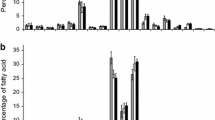Abstract
Pigeon “milk” (PM) collected from the crop of 1- to 5-day-old squabs was analyzed to examine whether there were changes in lipid composition during the first week of secretion. The high PM fat content (9–11%) remained fairly constant in the first 5 days of secretion. The mean percentage of neutral lipids, glycolipids and phospholipids was 80, 12 and 8%, respectively. Unlike the content of neutral lipids, glycolipid and phospholipid levels increased significantly between day 1 and day 5 of secretion. Triglycerides, the major neutral lipids, decreased by 24% between day 1 and day 5, while free sterols, monoglycerides and hydrocarbons increased by 8%, 11% and 2.5%, respectively, during the same period; diglycerides and sterol esters, however, remained unchanged. The ratio of saturated to unsaturated fatty acids was 0.27 and it remained unchanged. Medium-chain (C10, C12 and C14) and oddchain (C15 and C17) fatty acid contents were low. Fatty acids longer than C20 were absent. Palmitic acid, the major saturated fatty acid, increased by 42% from day 1 to day 5, whereas stearic acid decreased by 48% during the same period. Oleic acid, the predominant unsaturated fatty acid, also decreased from 51 to 45% between the first and fifth day of PM secretion. Polyunsaturated acids (18∶2, 18∶3 and 20∶4) accounted for 26% and 30% of the total fatty acids on day 1 and day 5, respectively. Although lipid changes in the crop of squabs prior to collection of samples cannot totally be ruled out, the nature of lipid changes is likely to reflect cellular breakdown that precedes PM secretion by parent pigeons.
Similar content being viewed by others
Abbreviations
- DG:
-
diglyceride(s)
- FID:
-
flame ionization detector
- PM:
-
pigeon “milk”
- TG:
-
triglyceride(s)
- TLC:
-
thin-layer chromatography
References
Griminger, P. (1983) inPhysiology and Behaviour of Pigeons (Abs, M., ed.), pp. 24–26, Academic Press, London.
Riddle, O., and Brancher, P.F. (1932)Am. J. Physiol., 97, 617–625.
Davies, W.L. (1939)Biochem. J. 33, 898–901.
Hegde, S.N. (1973)Ind. J. Exp. Biol. 11, 238–239.
Shetty, S., Shenoy, K.B., Jacob, R.T., and Hegde, S.N. (1990)Experientia 46, 449–451.
Hegde, S.N. (1972)Experientia 28, 1451–1452.
Desmeth, M., and Vandeputte-Poma, J. (1980)Comp. Biochem. Physiol. 66B, 129–133.
Pase, D.M., Landolt, P.A., and Mussehl, F.E. (1952)Growth 16, 279–285.
Folch, J., Lees, M., and Sloane-Stanley, G.H.S. (1957)J. Biol. Chem. 226, 497–509.
Wuthier, R.E. (1966)J. Lipid Res. 7, 558–561.
Ebercon, A., Blum, A., and Jordan, W.R. (1977)Crop. Sci. 17, 179–180.
Rouser, G., Kritchevsky, G., and Yamamoto, A. (1967) inLipid Chromatographic Analysis, Vol. 1, pp. 99–162, Marcel Dekker Inc., New York.
Dittmer, J.C., and Wells, M.A. (1969)Methods Enzymol. 14, 512–513.
Vorbeck, M.L., and Marinetti, G.V. (1965)J. Lipid Res. 6, 3–6.
Sweeley, C.C. (1969)Methods Enzymol. 14, 255–258.
Vogel, A.I. (1962) inTextbook of Practical Organic Chemistry, 3rd edn., p. 969, ELBS London.
Shetty, S., Sridhar, K.R., Shenoy, K.B., and Hegde, S.N. (1990)Folia Microbiol. 35, 240–244.
Jenness, R., and Sloan, R.E. (1970)Dairy Sci. Abstr. 32, 599–612.
Oftedal, O.T. (1984) inPhysiological Strategies in Lactation Symp. Zool. Soc. Lond. 51, 369–387.
Oftedal, O.T., Boness, D.J., and Bowen, W.D. (1988)Can. J. Zool. 66, 318–322.
Jenness, R. (1980)Dairy Sci. 63, 1605–1630.
Murty, V.L.N., Slomiany, B.L., Zdebska, E., Slomiany, A., Mandel, I.D., and Levy, M. (1984)Comp. Biochem. Physiol. 19A, 41–44.
Ashworth, O.S., Ramaiah, G.D., and Keyes, M.C. (1966)J. Dairy Sci. 49, 1206–1211.
Jenness, R. (1974) inLactation: A Comprehensive Treatise (Larson, B.L., and Smith, V.L., eds.) Vol. 3 pp. 8–23, Academic Press, New York.
Gibson, R.A., and Kneebone, G.M. (1981)Am. J. Clin. Nutr. 34, 252–257.
Author information
Authors and Affiliations
About this article
Cite this article
Shetty, S., Hegde, S.N. Changes in lipids of pigeon “milk” in the first week of its secretion. Lipids 26, 930–933 (1991). https://doi.org/10.1007/BF02535979
Received:
Revised:
Accepted:
Issue Date:
DOI: https://doi.org/10.1007/BF02535979




